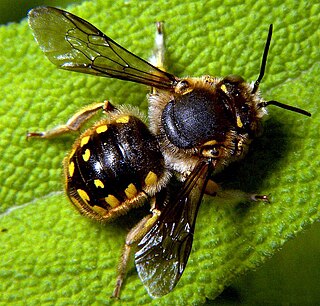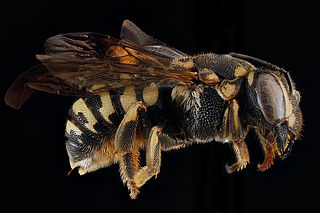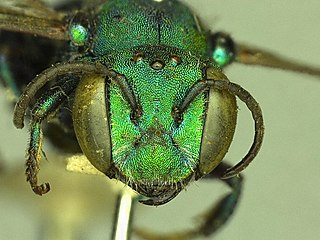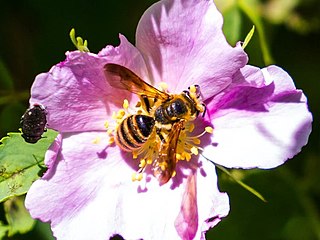
Megachilidae is a cosmopolitan family of mostly solitary bees. Characteristic traits of this family are the restriction of their pollen-carrying structure to the ventral surface of the abdomen, and their typically elongated labrum. Megachilid genera are most commonly known as mason bees and leafcutter bees, reflecting the materials from which they build their nest cells ; a few collect plant or animal hairs and fibers, and are called carder bees, while others use plant resins in nest construction and are correspondingly called resin bees. All species feed on nectar and pollen, but a few are kleptoparasites, feeding on pollen collected by other megachilid bees. Parasitic species do not possess scopae. The motion of Megachilidae in the reproductive structures of flowers is energetic and swimming-like; this agitation releases large amounts of pollen.

Hoplitis anthocopoides is a species in the family Megachilidae, in the order Hymenoptera . The distribution range of Hoplitis anthocopoides includes Africa, Europe, Northern Asia, and North America.
Osmia glauca is a species in the genus Osmia, in the family Megachilidae . It is found in North America.
Stelis perpulchra is a species of cuckoo bee in the family Megachilidae. It is found in Central America and North America.

Anthidiini is a tribe of insects in the family Megachilidae. There are at least 40 genera and 840 described species in Anthidiini. There is strong evidence that the tribe is monophyletic.

Lithurgopsis apicalis, the orange-tipped woodborer, is a species of woodborer bee in the family Megachilidae. Adults commonly visit flowers of Cactaceae, Malvaceae, and Asteraceae, with nests built in stalks of Agave.

Lithurgopsis is a genus of northern cactus woodborers in the family Megachilidae. There are at least nine described species in Lithurgopsis.
Habropoda pallida, known generally as the pallid habropoda or white-faced bee, is a species of anthophorine bee in the family Apidae. It is found in Central America and North America. Females build nests and are particularly likely to provision the young with pollen from Larrea tridentata plants.
Sapyga louisi is a species of a club-horned wasp in the family – Sapygidae. Adults feed from flowers and the larvae are kleptoparasites of leaf cutter bee larvae, including those of Heriades carinata.

Dianthidium simile is a species of leafcutter, mason, and resin bees in the family Megachilidae. It is found in North America.

Dianthidium is a genus of leafcutter, mason, and resin bees in the family Megachilidae. There are at least 20 described species in Dianthidium.

The cherry leaf miner bee is a species of miner bee in the family Andrenidae. Another common name for this species is cherry plum miner. It is found in Central America and North America.

Stelis is a genus of kleptoparasitic cuckoo bees in the family Megachilidae. There are at least 100 described species in Stelis.
The lonely miner bee is a species of miner bee in the family Andrenidae. It is found in Central America and North America.

Osmia foxi is a species of mason bees in the family Megachilidae. It is found in New Mexico and southeastern Arizona in the United States and in Sonora, Mexico.

Osmiini is a tribe of leafcutter, mason, and resin bees in the family Megachilidae. There are about 19 genera and at least 1,000 described species in Osmiini.

The golden-haired miner bee is a species of miner bee in the family Andrenidae. The female bees are 8 to 10 mm in length, and males are 6 to 9 mm long. It is found in the western United States, and is relatively rare outside California. It looks very similar to the death camas miner bee but is smaller.
Lasioglossum olympiae is a species of sweat bee in the family Halictidae.

Coelioxys banksi is a species of leafcutter bees in the family Megachilidae. It is a parasite of Megachile relativa nests.
Sphecodes mandibularis is a species of sweat bee in the family Halictidae.











